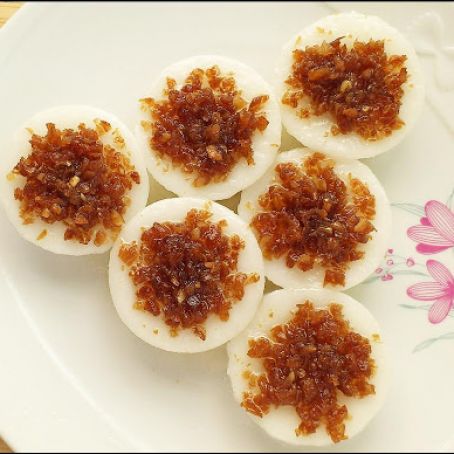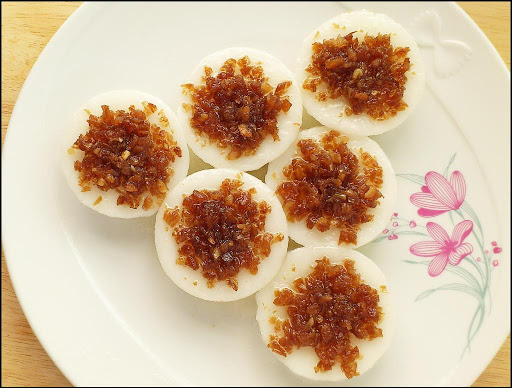Chwee kueh
By á-6184
There're several types of steamed cakes made with rice flour. If you want to learn how to make these traditional delicacies, chwee kueh would be a good start. It doesn't take long and the ingredients are cheap, so you don't waste much time or money if you fail.
The first step in making chwee kueh is mixing the batter. The main ingredient is rice flour but that alone would make a rather hard kueh. To soften it, you need to add some starch. Some people use tapioca flour; I prefer a mix of cornflour and wheat starch. Of course, the amount of water in the batter is crucial to the success of the steamed kueh. If the ratio of water to flour/starch is wrong, the steamed cake will be too hard or too soft.
If you have a good recipe, the only tricky part in making chwee kueh is the second step, when you thicken the batter. If the consistency is too thick, the steamed cake will be hard, and mushy if it's too thin.
You need to judge when to take the pot off the heat. How do you do that? By observing the batter. Once it's thick enough to coat the sides of the pot thinly, put the pot in a water-bath to stop the cooking.
Chwee kueh should have a slight depression in the middle after it's steamed. That's the classic hallmark of chwee kueh. In fact, it's the water collected in the depression that gives chwee kueh its name, which means "water cake".
Where does the water come from? The batter which, if it's thin, releases water when it's heated, creating a depression in the process. Thick batter doesn't do that because the water can't break away from the starch.
If the steamed cake doesn't have a depression and is level, that means it isn't as soft as it should be. Mind you, that's not always a bad thing. A cake that's a bit harder than it should be may be ready to eat straightaway after it's steamed. A soft cake, OTOH, needs to cool down and set before you can eat it. If you like your chwee kueh piping hot, you'd have to re-steam it.
To make a good topping, you must avoid overcooking the chai poh. It becomes chewy and tough if it's heated for too long, and it'll stick to your teeth. How do you tell when the chai poh is done? Just mix it with a wee bit of dark soya sauce for colour, then fry it with some minced garlic. It's done when the garlic is nicely golden brown.
What sort of chai poh should you use? Salted, not sweet. The latter isn't really sweet but is just kind of tasteless because it's been washed, excessively, to get rid of the salt. Of course, not all of the salted variety is good. The bad ones (like Pagoda brand) are mushy, have none of the fragrance of chai poh, and taste only of salt. Chwee kueh is nice only when the topping is crunchy and fragrant.
 1 Picture
1 Picture
Ingredients
- (Makes 20 pieces)
- Kueh
- 150 g rice flour
- 12 g wheat starch
- 12 g cornflour
- 1/2 tsp salt
- 2 tsp oil
- 300 ml room temperature water
- 400 ml boiling water
- Topping
- 150 g chopped chai poh (菜脯; salted turnip), Twin Rabbit brand
- 30 g garlic, peel and chop roughly
- 1/4 tsp dark soya sauce
- 120 ml vegetable oil
- 2 tbsp sugar
Details
Adapted from kitchentigress.blogspot.sg
Preparation
Step 1
To make kueh, thoroughly whisk rice flour, wheat starch, cornflour, salt, oil and 300 ml room temperature water. Add 400 ml boiling water. Whisk again. Cook over medium-low heat till just thick enough to coat sides of pot thinly, stirring constantly. Place pot in water-bath. Stir till half-cool.
Bring steamer to a boil. Place perforated tray in steamer. Arrange moulds, measuring 6 x 2 cm, slightly apart on tray. Fill moulds with batter to 3 mm from edge. Cover and bring steamer back to a boil. Steam 20 minutes over rapidly boiling water. Uncover. Cakes should have some water on top. If there is, steam uncovered till water evaporates, 1-2 minutes. Remove cakes from steamer.
Cakes should be mushy just after steaming. Leave to cool down and set. Resteam just before serving if you prefer hot/warm chwee kueh. If batter is overthickened before steaming, cakes may be set or half-set whilst piping hot.
To make topping, rinse chai poh twice. Drain in sieve, pressing to remove excess water. Transfer to mixing bowl. Add garlic and dark soya sauce. Mix thoroughly. Heat wok till hot. Place chai poh mixture in wok. Add enough oil to almost cover mixture, about 120 ml. Fry over medium-high heat till garlic is golden brown. Reduce heat to low. Add sugar and stir till dissolved. Turn off heat. Taste and if necessary adjust seasoning.
To serve, unmould chwee kueh and top with fried chai poh, along with some oil. Add sambal on the side if you like your chwee kueh spicy.

Review this recipe